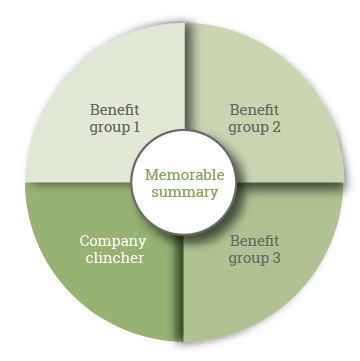Simplify Your Sales Message to Help Prospects Understand the Value of Your Offer
By Matt Troy, Director, Strategy
Hypothetically speaking, let’s say you’ve got fifteen minutes to talk to your biggest prospect next week at a conference in Atlanta. You’ve been hawking the buyer for eight months and you’ve finally got your meeting. You’ve narrowed down your entire portfolio to two major product lines you want to talk about. You’ve done your homework about where you need to be in order to be competitive on price and still hit your margin goal.
Internal inventory and supply chain are good. You’ve got clearance to sell in up to $750k for Q1 and Q2 of next year. Your main competitor’s product is old, overpriced and their spec sheet can’t hold a candle to yours. All signs point to an over-the-top slam dunk — cue the cash register — this is the type of opportunity you wait all year for…
And yet, more often than not, we see many really good salespeople walk out of these meetings without an agreement, without an order, and unfortunately, without a whole lot of insight as to what went wrong. If this is you, or has been you, don’t worry. You’re not alone, and if you’ve been on the wrong end of a few of these meetings, no need to go renew your real estate license. We’ve got a solution to help you close a lot more of these deals.
Simplify your sales message
When you do, your target will have a much easier time understanding the total value of your offering.
How do you do it?
- Spend less time on specs. If R&D did their job — and let’s assume they did — specs are nearly irrelevant. Your products had better be just as good, or better than anyone else’s. Mention that they are better, and move along.
- Spend less time on features. See #1 on this list. Chances are your products have most of the same features as your competitors — maybe one or two really exceptional ones. Mention those and move on.
- Spend the bulk or your time communicating bundles of end-user benefits:
- Take your feature and benefit lists and group all of your features and benefits into 3-4 benefit categories. Think time savings, think cost-of-use or ease-of-operation. These are good ‘high-level’ types of benefits that users find valuable – more so than just focusing on one or two features or specs of a product.
- Once all facets of your product are accounted for in your benefit categories, consider your company as a whole. In addition to providing product-related benefits, what services does your company offer that set your company apart from your competition? Think warranties, turnarounds on shipping or lead times, tech service knowledge, etc.
- Rank your product-related buckets of benefits 1-3 in order of importance based on what you know about your prospect. Do they have a campaign going about ease of use, safety or speed to completion? If so, align your benefits accordingly.
- Close with your company-related benefits. You want your prospect to walk away from the meeting remembering all the things your company does that the competition doesn’t.
- Summarize all four of your benefits with one memorable or unifying idea for your buyer to remember
When all of this comes together, think about delivering this as if you were working your way around a clock.

We’ve seen great success when clients simplify their messages in this way. Your targets love the structure — you’re able to gauge which parts of the message resonate better than others and from there, you’re able to do what you do best: close.
For help simplifying your sales message to create value for your products and your company, reach out to set up a work session where we can help you identify the greatest value for your products, product lines, and brands.


